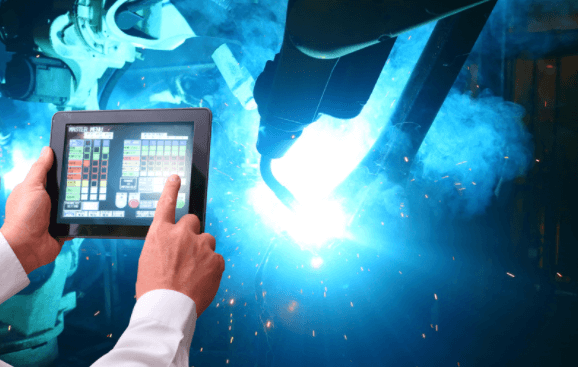Cloud technology saw dramatic adoption in the past decade. It has seeped into all facets of business and transformed how companies carry out operations. Cloud technology delivers huge scale advantages, intense collaborative power, and associated economic benefits. The manufacturing sector also has seen the rise in the adoption of cloud technologies to increase efficiency and profitability.
Cloud Manufacturing Technology
Cloud technology is making use of computational platforms and infrastructure over computer networks, mainly the internet. The use of cloud computing technology in the manufacturing sector is referred to as cloud manufacturing technology (CMfg). Cloud manufacturing technology is not a singular technology that is used in the manufacturing sector. It is a blending of various technologies that leverage data and networking to enhance manufacturing operations.
Some technologies that are part of the larger construct of cloud manufacturing technology are described briefly in the following sections.
Cloud Computing
Cloud service providers offer processing and storage capabilities without the need for maintaining the server facilities. Users can access the computational resources to process data on a pay-as-you-go model. The resources can be accessed from anywhere in the world and are highly scalable according to the needs.
Internet of Things (IoT)
Manufacturing facilities have several machines that make use of many sensors. If the information measured by these sensors is converted to digital data, it can be stored and analyzed. IoT devices do just that. The data measured by various sensors are converted to digital information and sent over the network. The data collected can be processed using cloud computing and edge computing technologies.
Virtualization
Virtualization is an option to run a virtual version of physical machines with the help of cloud technology or computational facilities available locally. This helps to monitor the operations of machines in real-time and receive feedback from OEMs. Digital twinning is the leading technological concept in the virtualization of manufacturing technology.
Data Science
Insights can be drawn from the large quantity of data collected using artificial intelligence and machine learning algorithms. It is not humanly possible to comb through and analyze data in the range of petabytes. AI/ML can analyze such large information and provide meaningful insights to improve operations.
Applications
The collection of various technologies used to improve manufacturing operations is given the umbrella term “cloud manufacturing technology.” They have a wide variety of applications from designing factory layouts to maintenance and repair operations. Some of the advantages of cloud manufacturing technologies are:
- Free flow of information
- 360-degree visibility of the entire operation
- Ability to scale up and scale down based on necessity
- Remote access of data
- High reliability of the information
- Predictive maintenance capability
- Interconnected supply chain
- Fast communication
- Easy to configure and flexible
The benefits of cloud manufacturing technology can be leveraged to:
- Increase the production quality
- Reduce the lead time
- Reduce cost
- Increase profitability
Some cloud manufacturing technology applications include:
Track And Trace
In a large manufacturing operation, it is difficult to track material within the factory floor. It becomes even more challenging to track material across the supply chain.Cloud manufacturing technology can keep track of a large quantity of material within the manufacturing facility and across the supply chain. Today consumers demand to know the provenance of the end product they consume. Using cloud manufacturing technology to track and trace products from raw materials to the end product in the consumer’s hands can be recorded, stored, and disseminated using cloud manufacturing technology.
Overall Equipment Effectiveness (OEE)
The productivity of a manufacturing process is measured in OEE. It is the measure of productive manufacturing time. The output quality, machine performance, and machine availability are factors that go into the calculation of OEE. An OEE score of 100% is the ideal scenario, but it is not always achievable. Being as close to the perfect score should be the target to improve the efficiency of the manufacturing plant.
It is cumbersome to manually monitor OEE regularly. Yet it is a critical metric that should be tracked in real-time. IoT technology enables the collection of real-time data from sensors and machines. This can be converted to an OEE score using cloud computing or edge computing making use of cloud technology. Data science can be used to analyze the data to identify the reasons for faltering performances. Cloud manufacturing technology can be used to monitor and improve OEE.
Factory Information System
Factory Information System (FIS) can act as the central hub for all information related to the plant operation. It can be used to monitor machine status and availability. FIS is also capable of creating real-time screens and reports automatically. Information regarding any part of the assembly line can be accessed with a single click from the FIS system. It can also be used to maintain documentation, SOPs, maintenance schedules, personnel details, etc.
FIS is capable of delivering such vast information to even remote users by leveraging cloud technology. IoT data can be used to track and record information in real-time regarding plant operations. It can also use the computational capability to engage in different predictions like predicting unscheduled downtime. FIS can also be synchronized with the sales data and the data from the logistics network to schedule manufacturing activities dynamically.
Error/Mistake Proofing
Cloud technology, especially image processing and machine learning, can be used to detect defective output. Manually checking millions of products churned out from a mass producer is virtually impossible. But cloud technology can be leveraged to detect defects in the output with imaging and applying AI algorithms on the images. This exercise can also give insights to reduce errors in the future.
Manufacturing Technology Endgame
Cloud manufacturing technology can be used as the first step in the creation of dark factories. Dark factories are factories that require no human intervention due to the fully automated nature of operations. Even without aiming for the endgame of manufacturing technology, cloud manufacturing delivers a much more productive manufacturing facility and improved operating margins.
Often manufacturers have to rely on multiple software to use different applications of cloud manufacturing technologies. RedViking’s Argonaut® is a single software solution that can bring about all the transformational capabilities of using cloud technology in manufacturing facilities. Leveraging cloud technology is important in the transformation of industry 3.0 to industry 4.0.







